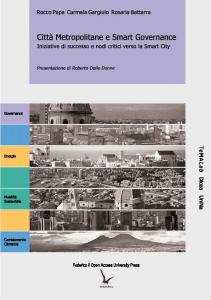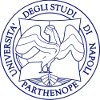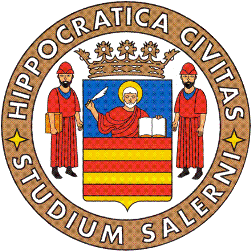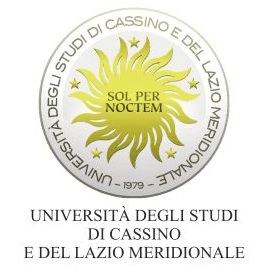Città Metropolitane e Smart Governance: Iniziative di successo e nodi critici verso la Smart City
Keywords:
Smart City, Metropolitan Areas, Smart Governance, ItalySinossi
Editore: FedOA Press (Federico II Open Access University Press).
Collana: Smart City, Urban Planning for a Sustainable Future.
Pagine: 597.
Lingua: Italiano.
NBN: http://nbn.depositolegale.it/urn:nbn:it:unina-22031
Abstract: Il volume raccoglie i risultati del progetto di ricerca "Governance Analysis Project (GAP) per la Smart Energy City. L'attuazione delle Smart City nelle aree metropolitane in Europa e in Italia" svolto nell'ambito del PON "Smart Energy Master per il governo energetico del territorio" presso l'Università Federico II di Napoli (TeMa Lab del Dipartimento di Ingegneria Civile, Edile e Ambientale).
Il tema delle Smart Cities ha assunto negli ultimi anni una crescente rilevanza nel dibattito scientifico e nella prassi operativa nazionale ed internazionale configurandosi come una delle opportunità per ripensare le città e più in generale la vita delle comunità urbane. Le prime riflessioni, ricerche e progetti sul tema sembrano convergere verso l'idea che uno sviluppo urbano "intelligente" sia frutto non soltanto delle pur necessarie e imprescindibili dotazioni infrastrutturali (capitale fisico) e di una loro continua innovazione, ma anche della qualità del capitale umano, sociale e dell' ambiente naturale, intesi come fattori strategici per lo sviluppo. Una città «smart» è, prima di tutto, una città capace di soddisfare efficacemente i bisogni dei suoi cittadini nel rispetto delle regole imposte dal contesto ambientale.
È in tale dibattito che si inquadra il progetto GAP la cui finalità è quella di affrontare il tema della Smart City alla luce della riorganizzazione amministrativa delle grandi città del nostro Paese promossa dalla L. 56/2014.
Con un approccio di tipo scientifico, il volume restituisce un quadro completo ed aggiornato di come le città metropolitane italiane ed europee stanno declinando il tema della smart city e ciò grazie alla costruzione di un ampissimo screening rappresentato da oltre 1.000 iniziative tra ricerche, progetti, interventi, tecnologie, ecc .. Inoltre un elemento di originalità della ricerca è rappresentato dal fatto che ad un' analisi compiuta attraverso fonti indirette, è seguita una fase di confronto con gli "attori" (e di ciò si fornisce un'ampia illustrazione nel volume nel quale vengono, tra l' altro, riportati ampi stralci delle interviste effettuate). Ciò ha consentito di restituire un quadro più aderente al vero di quanto oggi si sta sperimentando nelle città italiane ed europee, al di là di facili entusiasmi per interventi e progetti etichettati come "smart", ma per i quali non sempre possono essere individuati contenuti e metodi innovativi.
Il volume è articolato in 16 capitoli di cui:
- due capitoli presentano il confronto tra le 12 città metropolitane italiane, istituite dalla L.56/2014, con riferimento alle sperimentazioni in atto (cap. 1) e agli indicatori di smartness (cap. 14);
- un capitolo (cap.15) illustra come 5 città europee (Amsterdam, Barcellona, Berlino, Bristol e Bruxelles) stanno interpretando il modello Smart City;
- un capitolo (cap. 16) illustra le sperimentazioni in atto in 3 città metropolitane italiane (Milano, Venezia, Bologna) raccontate direttamente da coloro che stanno portando avanti gli interventi (tecnici di enti locali o associazioni);
- i restanti capitoli sono dedicati ognuno ad una delle 12 città metropolitane analizzate (Milano, Torino, Genova, Venezia, Bologna, Firenze, Roma, Napoli, Bari, Reggio Calabria, Palermo e Catania).
Downloads
Riferimenti bibliografici
http://www02.abb.com/db/db0003/db002698.nsf/0/0ea1c1498ed742dec1257a700032fbc8/$file/REPORT_ABBAmbrosetti_Completo.pdf.
Allwinkle, S., & Cruickshank, P. (2011). Creating Smart-er Cities: An Overview. Journal of Urban Technology, 18(2), 1-16. http://dx.doi.org/10.1080/10630732.2011.601103.
ARUP (2013). Smart actions in Italian metropolitan cities. Disponibile da
http://publications.arup.com/publications/s/smart_actions_in_italian_metropolitan_cities.
Barbieri, C.A. (2014). Città metropolitana: una sfida per innovare la pianificazione, Urbanistica Informazioni, 256, 104-105.
Barresi, A., & Pultrone, G. (2013). European Strategies for Smarter Cities. Tema. Journal Of Land Use, Mobility And Environment, 6(1), 61-72. http://dx.doi.org/10.6092/1970-9870/1455.
Battarra, R. (2014). Energy Component and Smart City Planning. In: R. Papa (cur.) Towards Smart City: a Scientific Approach. Roma, IT: Aracne Editrice.
Battarra, R., Fistola, R., La Rocca, R.A. (2016). City SmartNESS: the Energy Dimension of the Urban System. In R. Papa & R. Fistola (cur.), Smart Energy in the Smart City. Urban Planning for a Sustainable Future. Springer International Publishing. http://link.springer.com/book/10.1007%2F978-3-319-31157-9.
Batty, M., Axhausen, K.W., Giannotti, F., Pozdnoukhov, A., Bazzani, A., Wachowicz, M., Ouzounis, G., & Portugali, Y. (2012). Smart cities of the future. The European Physical Journal Special Topics, 214, 481–518. http://dx.doi.org/10.1140/epjst/e2012-01703-3.
Batty, M. (2013). Big data, smart cities and city planning. Dialogues in Human Geography, 3(3), http://dx.doi.org/10.1177/2043820613513390.
Bencardino, M. & Greco, I. (2014). Smart Communties. Social Innovation at the Service of the Smart Cities. Tema. Journal of Land Use, Mobility and Environment. 7 (Special Issue INPUT 2014). http://dx.doi.org/10.6092/1970-9870/2533.
Bettencourt, L. (2013). The Uses of Big Data in Cities. Santa Fe: Santa Fe InstituteWorkingPaper. Disponibile da: http://www.santafe.edu/media/workingpapers/13-09-029.pdf.
Between (2014). Smart city index. Disponibile da: http://www.smartcityitalia.net/wp-content/uploads/2014/06/Between_SmartCityIndex2014.pdf.
Bronzini, F., Imbesi, P.N. & Bedini, M.A. (2014). La misura del Piano. Roma, IT: Gangemi Editore.
Calderini M. (2014). Perché le smart city hanno sprecato quasi un miliardo di euro pubblici e come rimedieremo. Disponibile da: http://www.agendadigitale.eu/smart-cities-communities/1231_perche-le-smart-city-hanno-sprecato-quasi-un-miliardo-di-euro-pubblici-e-come-rimedieremo.htm.
Caragliu, A., Del Bo, C., & Nijkamp, P. (2009). Smart cities in Europe. Journal of Urban Technology, 18(2), 65-82. http://dx.doi.org/10.1080/10630732.2011.601117.
Carta, M. (2012). Creative City 3.0: smart cities for the urban age. In A. Vergano & A. Caruana (cur.), Smart Planning for Europe’s Gateway Cities. Connecting Peoples, Economies and Places, Atti del IX Biennal of European Towns and Town Planners. Genova, 14-17 settem¬bre 2011. Roma, IT: Inu Edizioni.
Carta, M. (2013). Open Urbanism. Progettare città senzienti e dialogiche, Opere, 34, 88-93. Di¬sponibile da
https://iris.unipa.it/retrieve/handle/10447/70879/57352/235%20Open%20Urbanism%20%28Opere_34%202013%29.pdf.
Carta, M. (2014). Reimagining Urbanism. Creative, Smart and Green Cities for the Changing Times. Trento, IT: ListLab.
Censis (2014). Rileggere i territori per dare identità e governo all’area vasta. Il governo delle aree metropolitane in Europa. Report di ricerca. Disponibile da http://www.upinet.it/docs/contenuti/2013/11/Rapporto%20finale%20DEFINITIVO%20_28%20ottobre%202013_.pdf.
Claser, A., Fazioli, R., & Vecchia, P. (2014). Progettare la sostenibilità. La riflessione, la sfida, la progettazione. Padova, IT: Libreriauniversitaria.
Colorni, A., Lia F. & Sciuto, D. (cur.) (2014). Smart city: tecnologia e creatività a supporto dell’innovazione. Milano, IT: Fondazione Ansaldo Editore.
Daly, H. (1978). Steady-State Economics: The Economics of Biophysical Equilibrium and Moral Growth. Washington, DC: Island press.
De Luca, G. & Moccia, F.D. (2015). Immagini di territori metropolitani. Roma, IT: INU Edizioni.
De Santis R., Fasano A., Mignolli N., Villa A. (2013). Il quadro concettuale e le esperienze di misurazione delle Smart Cities. MPRA Paper No. 50207, posted 26, September. Disponibile da https://mpra.ub.uni-muenchen.de/50207/.
Dipartimento per lo Sviluppo e la Coesione Economica. (2014). Programma Operativo Nazionale Città Metropolitane 2014-2020. Disponibile da
http://www.agenziacoesione.gov.it/opencms/export/sites/dps/it/documentazione/PON_metro/PON_Citta_Metropolitane.pdf.
Forum PA. (2013). ICity rate 2014. La classifica delle città intelligenti italiane. Disponibile da http://www.icitylab.it/il-rapporto-icityrate/edizione-2014/.
Gabellini, P. (2013). Capire il carattere della crisi, agire gradualmente e selettivamente, accettare la parzialità. In L. Fragolent & M. Savino (cur.). Città e politiche in tempo di crisi. Milano, IT: FrancoAngeli.
Galderisi, A., Mazzeo, G. & Pinto, F. (2016). Cities Dealing with Energy Issues and Climate- Related Imapcts: Approaches, Strategies and Tools for a Sustainable Urban Development. In R. Papa & R. Fistola (cur.), Smart Energy in the Smart City. Urban Planning for a Sustainable Future. Springer International Publishing. http://link.springer.com/book/10.1007%2F978-3-319-31157-9.
Gargiulo, C. (2014). Integrazione trasporti-territorio. Strumenti, interventi e best practices verso la Smart City. Napoli, IT: Clean.
Gargiulo, C., Zucaro, F. (2015). Smartness and Urban Resilience. A Model of Energy Saving. Tema. Journal of Land Use, Mobility and Environment. 8 (Special Issue ECCA 2015). http://dx.doi.org/10.6092/1970-9870/3661.
Gargiulo Morelli, V., Weijnen, M., von Bueren, E., Wenzler, I. De Reuver, M. & Saheti, L. (2013). Towards Intelligently-Sustainable Cities? Tema. Journal of Land Use, Mobility and Environment, 6(1). http://dx.doi.org/10.6092/1970-9870/1496.
Georgescu-Roegen, N. (1975). Energy and economic myths. Southern Economic Journal, 41(3), 347-381. Disponibile da http://www.uvm.edu/~jfarley/EEseminar/readings/energy%20myths.pdf.
Giffinger, R., Fertner, C., Kramar, H., Kalasek, R., Pichler-Milanovic, N., & Meijers, E. (2007). Smart Cities: Ranking of European Medium-Sized Cities. Vienna, AU: Centre of Regional Science (SRF), Vienna University of Technology. Disponibile da http://www.smart-cities.eu/download/smart_cities_final_report.pdf.
Giffinger, R. (2015). European Smart Cities-Larger European cities (version 4.0). Disponibile da http://www.smart-cities.eu.
Hall R. E. (2000). The vision of a Smart City. In: Proceedings of 2nd International Life Extension Technology Worshop, Paris, France, September 28.
Haplern, D. (2005). Social Capital. Cambridge, UK: Polity Press.
Hollands, R. (2008). Will the real Smart City please stand up?. City, 12(3), 303-320. http://dx.doi.org/10.1080/13604810802479126.
Las Casas, G., Lombardo, S., Murgante, B., Pontrandolfi, P. & Scorza, F. (2014). Open Data for Territorial Specialization Assessment Territorial Specialization in Attracting Local Development Funds: an Assessment. Procedure Based on Open Data and Open Tools. Tema. Journal of Land Use, Mobility and Environment, 7 (Special Issue INPUT 2014). http://dx.doi.org/10.6092/1970-9870/2557.
Leydesdorff, L. & Deakin M. (2011). The triple-helix model of smart cities: a neo-evolutionary perspective. Journal of Urban Technology, 18(2), 53-63. http://dx.doi.org/10.1080/10630732.2011.601111.
Manville, C., Cochrane, G., Cave, J., Millard, J., Pederson, J. K., Thaarup, R. K., Liebe, A., Wissner, M., Massink, R., & Kotterink, B. (2014). Mapping smart cities in the EU. Bruxelles, BE: European Parliament, Policy Department A: Economic and Scientific Policy. http://dx.doi.org/10.2861/3408.
Marotta, G., Pastena, E. (cur.). (2013). Le città metropolitane. Padova, IT: Cedam.
MIT (2013) ‘Smart Cities Group’, Cambridge, MA. Disponibile da http://smartcities.media.mit.edu/.
Moccia, F.D. (2012). Urbanistica. Napoli, IT: CLEAN.
Moccia, F.D., & Sgobbo, A. (2013). La polarizzazione metropolitana. Napoli, IT: Liguori Editore.
Mosannenzadeh, F., & Vettorato, D. (2014). Defining Smart City. A Conceptual Framework Based on Keyword Analysis. Tema. Journal Of Land Use, Mobility And Environment, 7 (Special Issue INPUT 2014). http://dx.doi.org/10.6092/1970-9870/2523.
Neirotti, P., De Marco, A., Cagliano, A. C., Mangano, G., & Scorrano, F. (2014). Current trends in Smart City initiatives: Some stylised facts. Cities, 38, 25-36. http://dx.doi.org/10.1016/j.cities.2013.12.010.
Papa, E. & Lauwers, D. (2015). Smart Mobility: Opportunity or Threat to Innovate Places and Cities. In: 20th International Conference on Urban Planning and Regional Development in the Information Society, Proceedings. Disponibile da https://biblio.ugent.be/publication/5937340/file/5937341.pdf.
Papa, R., Gargiulo, C., & Galderisi, A. (2013). Towards an urban planners’ perspective on smart city, Tema. Journal of Land Use, Mobility and Environment, 6(1), 5-17. http://dx.doi.org/10.6092/1970-9870/1536.
Papa, R. (cur.). (2014). Towards Smart City, a Scientific Approach. Roma, IT: Aracne.
Papa, R., Gargiulo, C., Franco, S., & Russo, L. (2014). Urban Smartness Vs Urban Competitiveness: A Comparison of Italian Cities Rankings. Tema. Journal of Land Use, Mobility and Environment, 7 (Special Issue INPUT 2014). http://dx.doi.org/10.6092/1970-9870/2555.
Papa, R., Galderisi, A., Vigo Majello M.C., Saretta E. (2015). Smart and resilient cities. A systemic approach for developing cross-sectoral strategies in the face of climate change. Tema. Journal of Land Use, Mobility and Environment, 8(1), 19-49. http://dx.doi.org/10.6092/1970-9870/2883.
Papa, R., Gargiulo, C., & Zucaro, F. (2016). Towards the Definition of the Urban Saving Energy Model (UrbanSEM). In R. Papa & R. Fistola (cur.), Smart Energy in the Smart City. Urban Planning for a Sustainable Future. Springer International Publishing. http://link.springer.com/book/10.1007%2F978-3-319-31157-9.
Papa, R., Gargiulo, C., Zucaro, F. Cristiano, M., Angiello, G., & Carpentieri, G. (2016). Energy and Climate Change Polices in Europe: Overview and Selected Examples from a Spatial Planning Perspective. In R. Papa & R. Fistola (cur.), Smart Energy in the Smart City. Urban Planning for a Sustainable Future. Springer International Publishing. http://link.springer.com/book/10.1007%2F978-3-319-31157-9.
Pizzetti, F. (2015). Le città metropolitane per lo sviluppo strategico del territorio: tra livello locale e livello sovranazionale. Federalismi.it. Rivista di diritto pubblico italiano, comparato, europeo, 12.
Disponibile da http://www.federalismi.it/nv14/articolo-documento.cfm?Artid=29747.
Rifkin, J. (1980). Entropy: A new world view. New York, NY: Viking Press.
Rifkin, J. (2009). The empathic civilization. New York, NY: Tatcher.
Rifkin, J. (2011). La terza rivoluzione industriale. Milano, IT: Edizioni Mondadori.
Scalzo, A. (cur.). (2008). ICT e Innovazione. La politica regionale di sviluppo 2007-2013 nella dimensione urbana: analisi delle opportunità. Roma, IT: Cittalia. Disponibile da: http://ita.calameo.com/read/000117965c352a1538a54.
Schuuman, D., Baccarne, B., de Marez, L., & Mechant, P. (2012). Smart Ideas for Smart Cities: In¬vestigating Crowdsourcing for Generating and Selecting Ideas for ICT Innovation in a City Context. Journal of Theoretical and Applied Electronic Commerce Research, 7(3), 49-62. http://dx.doi.org/10.4067/S0718-18762012000300006.
Siegele L. (2012). Mining the urban data, The Economist June 2nd.
Testa, P. (cur.). (2013). Le città metropolitane. Rapporto Cittalia 2013. Roma, IT: Fondazione Anci Ricerche. Disponibile da: http://www.cittalia.it/.
Townsend, A. (2001). Network Cities and the Global Structure of the Internet. American Behavioral Scientist, 10(44), 1697-1716. Disponibile da: http://dx.doi.org/10.1177/00027640121957998.
Ugolini, P., Pirlone, F., & Spadaro, I. (2011). Mobilità partecipata: Agenda XXI e buone pratiche. Tema. Journal of Land Use, Mobility And Environment, 4(4), 25-34. http://dx.doi.org/10.6092/1970-9870/507.
Verones S., & Zanon, B. (2012). Energia e pianificazione urbanistica. Verso un’integrazione delle politiche urbane. Milano, IT: FrancoAngeli.
Wolfram, M. (2012). Deconstructing Smart Cities: An Intertextual Reading of Concepts and Prac¬tices for Integrated Urban and ICT Development. Proceedings of 17th International Confer¬ence on Urban Planning, Regional Development and Information Society, Schewechat, 14-16 mag¬gio (171-181). Disponibile da http://programm.corp.at/cdrom2012/papers2012/CORP2012_192.pdf.
















